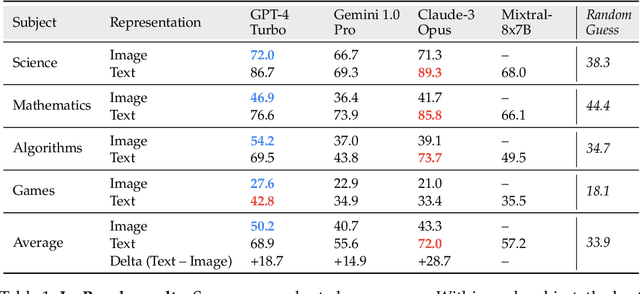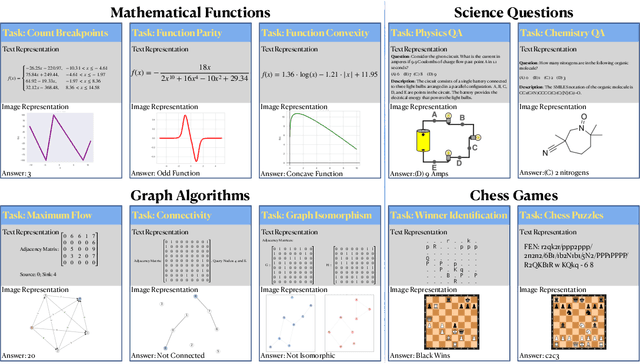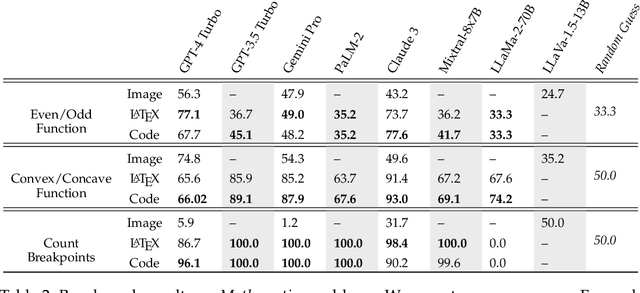Ollie Liu
Advances and Challenges in Foundation Agents: From Brain-Inspired Intelligence to Evolutionary, Collaborative, and Safe Systems
Mar 31, 2025Abstract:The advent of large language models (LLMs) has catalyzed a transformative shift in artificial intelligence, paving the way for advanced intelligent agents capable of sophisticated reasoning, robust perception, and versatile action across diverse domains. As these agents increasingly drive AI research and practical applications, their design, evaluation, and continuous improvement present intricate, multifaceted challenges. This survey provides a comprehensive overview, framing intelligent agents within a modular, brain-inspired architecture that integrates principles from cognitive science, neuroscience, and computational research. We structure our exploration into four interconnected parts. First, we delve into the modular foundation of intelligent agents, systematically mapping their cognitive, perceptual, and operational modules onto analogous human brain functionalities, and elucidating core components such as memory, world modeling, reward processing, and emotion-like systems. Second, we discuss self-enhancement and adaptive evolution mechanisms, exploring how agents autonomously refine their capabilities, adapt to dynamic environments, and achieve continual learning through automated optimization paradigms, including emerging AutoML and LLM-driven optimization strategies. Third, we examine collaborative and evolutionary multi-agent systems, investigating the collective intelligence emerging from agent interactions, cooperation, and societal structures, highlighting parallels to human social dynamics. Finally, we address the critical imperative of building safe, secure, and beneficial AI systems, emphasizing intrinsic and extrinsic security threats, ethical alignment, robustness, and practical mitigation strategies necessary for trustworthy real-world deployment.
METAGENE-1: Metagenomic Foundation Model for Pandemic Monitoring
Jan 03, 2025



Abstract:We pretrain METAGENE-1, a 7-billion-parameter autoregressive transformer model, which we refer to as a metagenomic foundation model, on a novel corpus of diverse metagenomic DNA and RNA sequences comprising over 1.5 trillion base pairs. This dataset is sourced from a large collection of human wastewater samples, processed and sequenced using deep metagenomic (next-generation) sequencing methods. Unlike genomic models that focus on individual genomes or curated sets of specific species, the aim of METAGENE-1 is to capture the full distribution of genomic information present within this wastewater, to aid in tasks relevant to pandemic monitoring and pathogen detection. We carry out byte-pair encoding (BPE) tokenization on our dataset, tailored for metagenomic sequences, and then pretrain our model. In this paper, we first detail the pretraining dataset, tokenization strategy, and model architecture, highlighting the considerations and design choices that enable the effective modeling of metagenomic data. We then show results of pretraining this model on our metagenomic dataset, providing details about our losses, system metrics, and training stability over the course of pretraining. Finally, we demonstrate the performance of METAGENE-1, which achieves state-of-the-art results on a set of genomic benchmarks and new evaluations focused on human-pathogen detection and genomic sequence embedding, showcasing its potential for public health applications in pandemic monitoring, biosurveillance, and early detection of emerging health threats.
Euclid: Supercharging Multimodal LLMs with Synthetic High-Fidelity Visual Descriptions
Dec 11, 2024Abstract:Multimodal large language models (MLLMs) have made rapid progress in recent years, yet continue to struggle with low-level visual perception (LLVP) -- particularly the ability to accurately describe the geometric details of an image. This capability is crucial for applications in areas such as robotics, medical image analysis, and manufacturing. In this paper, we first introduce Geoperception, a benchmark designed to evaluate an MLLM's ability to accurately transcribe 2D geometric information from an image. Using this benchmark, we demonstrate the limitations of leading MLLMs, and then conduct a comprehensive empirical study to explore strategies for improving their performance on geometric tasks. Our findings highlight the benefits of certain model architectures, training techniques, and data strategies, including the use of high-fidelity synthetic data and multi-stage training with a data curriculum. Notably, we find that a data curriculum enables models to learn challenging geometry understanding tasks which they fail to learn from scratch. Leveraging these insights, we develop Euclid, a family of models specifically optimized for strong low-level geometric perception. Although purely trained on synthetic multimodal data, Euclid shows strong generalization ability to novel geometry shapes. For instance, Euclid outperforms the best closed-source model, Gemini-1.5-Pro, by up to 58.56% on certain Geoperception benchmark tasks and 10.65% on average across all tasks.
Game-theoretic LLM: Agent Workflow for Negotiation Games
Nov 12, 2024



Abstract:This paper investigates the rationality of large language models (LLMs) in strategic decision-making contexts, specifically within the framework of game theory. We evaluate several state-of-the-art LLMs across a spectrum of complete-information and incomplete-information games. Our findings reveal that LLMs frequently deviate from rational strategies, particularly as the complexity of the game increases with larger payoff matrices or deeper sequential trees. To address these limitations, we design multiple game-theoretic workflows that guide the reasoning and decision-making processes of LLMs. These workflows aim to enhance the models' ability to compute Nash Equilibria and make rational choices, even under conditions of uncertainty and incomplete information. Experimental results demonstrate that the adoption of these workflows significantly improves the rationality and robustness of LLMs in game-theoretic tasks. Specifically, with the workflow, LLMs exhibit marked improvements in identifying optimal strategies, achieving near-optimal allocations in negotiation scenarios, and reducing susceptibility to exploitation during negotiations. Furthermore, we explore the meta-strategic considerations of whether it is rational for agents to adopt such workflows, recognizing that the decision to use or forgo the workflow constitutes a game-theoretic issue in itself. Our research contributes to a deeper understanding of LLMs' decision-making capabilities in strategic contexts and provides insights into enhancing their rationality through structured workflows. The findings have implications for the development of more robust and strategically sound AI agents capable of navigating complex interactive environments. Code and data supporting this study are available at \url{https://github.com/Wenyueh/game_theory}.
MatViX: Multimodal Information Extraction from Visually Rich Articles
Oct 27, 2024Abstract:Multimodal information extraction (MIE) is crucial for scientific literature, where valuable data is often spread across text, figures, and tables. In materials science, extracting structured information from research articles can accelerate the discovery of new materials. However, the multimodal nature and complex interconnections of scientific content present challenges for traditional text-based methods. We introduce \textsc{MatViX}, a benchmark consisting of $324$ full-length research articles and $1,688$ complex structured JSON files, carefully curated by domain experts. These JSON files are extracted from text, tables, and figures in full-length documents, providing a comprehensive challenge for MIE. We introduce an evaluation method to assess the accuracy of curve similarity and the alignment of hierarchical structures. Additionally, we benchmark vision-language models (VLMs) in a zero-shot manner, capable of processing long contexts and multimodal inputs, and show that using a specialized model (DePlot) can improve performance in extracting curves. Our results demonstrate significant room for improvement in current models. Our dataset and evaluation code are available\footnote{\url{https://matvix-bench.github.io/}}.
IsoBench: Benchmarking Multimodal Foundation Models on Isomorphic Representations
Apr 02, 2024



Abstract:Current foundation models exhibit impressive capabilities when prompted either with text only or with both image and text inputs. But do their capabilities change depending on the input modality? In this work, we propose $\textbf{IsoBench}$, a benchmark dataset containing problems from four major areas: math, science, algorithms, and games. Each example is presented with multiple $\textbf{isomorphic representations}$ of inputs, such as visual, textual, and mathematical presentations. IsoBench provides fine-grained feedback to diagnose performance gaps caused by the form of the representation. Across various foundation models, we observe that on the same problem, models have a consistent preference towards textual representations. Most prominently, when evaluated on all IsoBench problems, Claude-3 Opus performs 28.7 points worse when provided with images instead of text; similarly, GPT-4 Turbo is 18.7 points worse and Gemini Pro is 14.9 points worse. Finally, we present two prompting techniques, $\textit{IsoCombination}$ and $\textit{IsoScratchPad}$, which improve model performance by considering combinations of, and translations between, different input representations.
DeLLMa: A Framework for Decision Making Under Uncertainty with Large Language Models
Feb 04, 2024Abstract:Large language models (LLMs) are increasingly used across society, including in domains like business, engineering, and medicine. These fields often grapple with decision-making under uncertainty, a critical yet challenging task. In this paper, we show that directly prompting LLMs on these types of decision-making problems yields poor results, especially as the problem complexity increases. To overcome this limitation, we propose DeLLMa (Decision-making Large Language Model assistant), a framework designed to enhance decision-making accuracy in uncertain environments. DeLLMa involves a multi-step scaffolding procedure, drawing upon principles from decision theory and utility theory, to provide an optimal and human-auditable decision-making process. We validate our framework on decision-making environments involving real agriculture and finance data. Our results show that DeLLMa can significantly improve LLM decision-making performance, achieving up to a 40% increase in accuracy over competing methods.
On Retrieval Augmentation and the Limitations of Language Model Training
Nov 16, 2023Abstract:Augmenting a language model (LM) with $k$-nearest neighbors (kNN) retrieval on its training data alone can decrease its perplexity, though the underlying reasons for this remains elusive. In this work, we first rule out one previously posited possibility -- the "softmax bottleneck." We further identify the MLP hurdle phenomenon, where the final MLP layer in LMs may impede LM optimization early on. We explore memorization and generalization in language models with two new datasets, where advanced model like GPT-3.5-turbo find generalizing to irrelevant information in the training data challenging. However, incorporating kNN retrieval to vanilla GPT-2 117M can consistently improve performance in this setting.
Interpretable Diffusion via Information Decomposition
Oct 12, 2023Abstract:Denoising diffusion models enable conditional generation and density modeling of complex relationships like images and text. However, the nature of the learned relationships is opaque making it difficult to understand precisely what relationships between words and parts of an image are captured, or to predict the effect of an intervention. We illuminate the fine-grained relationships learned by diffusion models by noticing a precise relationship between diffusion and information decomposition. Exact expressions for mutual information and conditional mutual information can be written in terms of the denoising model. Furthermore, pointwise estimates can be easily estimated as well, allowing us to ask questions about the relationships between specific images and captions. Decomposing information even further to understand which variables in a high-dimensional space carry information is a long-standing problem. For diffusion models, we show that a natural non-negative decomposition of mutual information emerges, allowing us to quantify informative relationships between words and pixels in an image. We exploit these new relations to measure the compositional understanding of diffusion models, to do unsupervised localization of objects in images, and to measure effects when selectively editing images through prompt interventions.
Approximating CKY with Transformers
May 03, 2023



Abstract:We investigate the ability of transformer models to approximate the CKY algorithm, using them to directly predict a parse and thus avoid the CKY algorithm's cubic dependence on sentence length. We find that on standard constituency parsing benchmarks this approach achieves competitive or better performance than comparable parsers that make use of CKY, while being faster. We also evaluate the viability of this approach for parsing under random PCFGs. Here we find that performance declines as the grammar becomes more ambiguous, suggesting that the transformer is not fully capturing the CKY computation. However, we also find that incorporating additional inductive bias is helpful, and we propose a novel approach that makes use of gradients with respect to chart representations in predicting the parse, in analogy with the CKY algorithm being the subgradient of a partition function variant with respect to the chart.
 Add to Chrome
Add to Chrome Add to Firefox
Add to Firefox Add to Edge
Add to Edge